Poisonous Animals
Planet earth is home to many animals, some of them have developed a unique mechanism for feeding and protecting themselves. They produce deadly toxins that are poisonous to other creatures. A single bite from these deadly creatures could prove near-fatal to humans.
LD50 is a scale that measures the toxicity of any chemical. Lethal Dose (LD) is defined, as the dose required to kill, half the members of a specific animal population.
This is an indicator measuring chemical’s toxicity within a short period. It is a measure of acute toxicity of a substance. Based on the toxicity of chemicals produced by animals, here is the list of the top five poisonous animals that produce the most toxic chemicals even a small dose of these potent toxins can be fatal to humans.
Check out the top five poisonous animals:
Top 5 Poisonous Animals
 Funnel Web Spider: Known by the scientific name of Atrax robustus, they are native of eastern Western Australia. These spiders are good swimmers. Their name derives from the fact that they prepare a dense web in the shape of a funnel and reside at the centre of the funnel and wait for their prey.
Funnel Web Spider: Known by the scientific name of Atrax robustus, they are native of eastern Western Australia. These spiders are good swimmers. Their name derives from the fact that they prepare a dense web in the shape of a funnel and reside at the centre of the funnel and wait for their prey.
Their body ranges up to 5 centimetres long. Their prey includes frogs, lizards and insects that come across its path by injecting them with their potent venom. Only male spiders are loaded with toxic venom, though female spiders are also venomous, they are less toxic.
The venom of these spiders has atracotoxin, that produce spontaneous reactions leading to muscle spasms, diarrhoea and vomiting in 15 min after being bitten eventually leading to cardiac arrest. The patient needs to be rushed to the hospital and provided two vials of anti-venom.
They are ill-tempered and cranky spiders that fiercely guard their webs. Their venom has an LD50 of 0.16mg/Kg. Their venom is so potent that mere injection of 9mg can kill a person weighing 60 kilos.
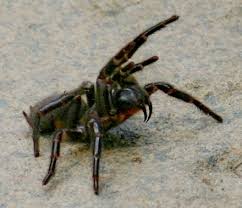
 Cone Snail: Cone snail is a slow-moving creature, possessing a venomous harpoon that lashes out at prey. They are found worldwide in the warm and tropical seas mainly of Indo Pacific Sea in the shallow areas. These snails look harmless at first, but looks can be deceiving. They feed on worms and small fishes.
Cone Snail: Cone snail is a slow-moving creature, possessing a venomous harpoon that lashes out at prey. They are found worldwide in the warm and tropical seas mainly of Indo Pacific Sea in the shallow areas. These snails look harmless at first, but looks can be deceiving. They feed on worms and small fishes.
The harpoon is loaded with neurotoxin venom so potent that there is no anti-venom till date. This venom is a mixture of toxins and peptides. The larger the snail, the greater amount of toxins they possess.
The snail paralyses the prey instantaneously gradually swallowing it. These snails are often brightly coloured and catching a live snail with the hand may prove fatal. The venom reduces the heart rate and shuts down the nervous system cells.
The venom of this snail has an LD50 of 0.12mg/Kg. Their venom is so potent that mere injection of 7mg of it can kill a person weighing 60 kilos.
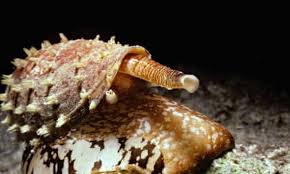
 Box Jelly Fish: Box Jelly Fish, has a box-like squarish shape, from each corner hangs the hollow tentacles. They have true eyes complete with the retina. A fully grown box jellyfish can measure to 20cm, and their tentacles can extend to 3m in length.
Box Jelly Fish: Box Jelly Fish, has a box-like squarish shape, from each corner hangs the hollow tentacles. They have true eyes complete with the retina. A fully grown box jellyfish can measure to 20cm, and their tentacles can extend to 3m in length.
They feed on small fish and have a life expectancy of around 60 days, and capable of achieving a speed of 7 km/hr. Found in the tropical waters of the Indo-Pacific region. The tentacles of the box jellyfish push a toxin, filled with nematocysts.
Once termed as the “World’s most venomous creature”, the venom of box jellyfish are mixtures of bioactive proteins that can cause agonizing pain, inflammation, tissue damage and in a cardiovascular collapse in extreme circumstances.
The venom of this boxed jellyfish has an LD50 of 0 .04mg/Kg. Their venom is so potent that a mere injection of 4.1 mg can kill a fully grown man of 60 Kilos.
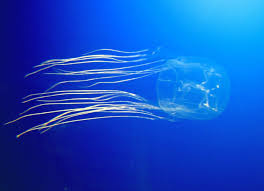
 Inland Taipan Snake:
Inland Taipan Snake:
Inland taipan, belonging to the family of Elapidae, possess the most toxic venom of any snake. Found in the black soil plains of western and southern Australia. They are dark tan and prefer to live inside burrows.
They have the most accurate bite among snakes and feed on rodents and rats. After biting, they retreat for their prey to die before consuming them. Their venom consists of a potent mixture of hemotoxins, myotoxins and neurotoxins.
One bite of this snake has the potential to kill 100 humans with the amount of toxin released. The venom leads to interference in blood clotting, paralysis, renal failure, and eventually leading to respiratory failure and cardiac arrest.
The venom of this snake has an LD50 of 0 .025mg/Kg. Their venom is so potent that a mere injection of 1.5 mg can kill a fully grown man of 60 Kilos.
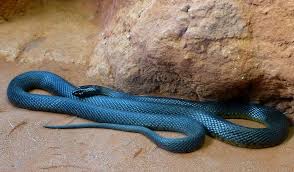
![]() Poison Dart Frog: Poison dart frog, a native of tropical South and Central America. Found in humid tropical rain forests marshes, rivers and swamps. They are brightly coloured and feeds on ants and mice.
Poison Dart Frog: Poison dart frog, a native of tropical South and Central America. Found in humid tropical rain forests marshes, rivers and swamps. They are brightly coloured and feeds on ants and mice.
Many species of dart frogs exist in nature, but the most toxic among them belongs to the species of phyllobates terribilis. They secrete a deadly mixture of toxins from their skin glands mainly to ward of predators.
The alkaloid toxin secreted consists of a toxic mixture of Batrachotoxin and Epibatedine. The potent toxin from the skin of the frog is long used by natives of the forests to smear the arrow tips that help them in hunting large animals.
The toxin is released from the gland when the frog is either agitated or feels threatened. They do not produce these toxins themselves; rather they gain these toxins from insects, worms and ants they eat. The potency of the toxin depends upon the diet of the frogs.
Batrachotoxin is one of the most potent alkaloid toxins, a neurotoxin that impacts the nerve cell and prevents it from sending signals. This toxin also has an immediate impact on the heart by interfering with heart contractions leading to cardiac arrest.
The toxicity of this secretion is so venomous, that 0 .12 mg is enough to fully grown man of 60 Kilos and there is no antidote available.
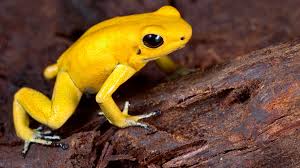




 (2 votes, average: 5.00 out of 5)
(2 votes, average: 5.00 out of 5)


